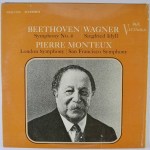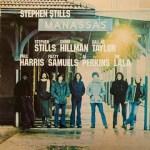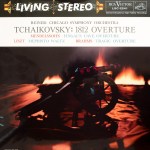
More of the Music of Neil Young
Reviews and Commentaries for the Music of Neil Young
When I reviewed the Classic Records record in 2005, I had never heard of Chris Bellman. As it turns out, he’s the guy who cut this piece of crap. I had no idea. And why would I care anyway?
The most shocking thing about the fact that he cut the album is not how awful it sounds.
No, there are plenty of awful sounding Heavy Vinyl pressings in the world, enough to fill up the glossy-paged catalogs of every mail order audiophile record dealer from here to Timbuktu.
What is shocking is that there are audiophiles — self-identified lovers of sound who are supposedly capable of telling a good sounding record from a hole in the ground — that defend this man’s work.
How does anyone take this guy’s records seriously?
To be fair, it should be said that I like one of the records Mr Bellman has cut, the 45 of Brothers in Arms, discussed here. An excerpt:
[In this video] I’m asked if I like any modern mastering engineers, and the only one I can think of is Chris Bellman, because he masterered one of the few Heavy Vinyl pressings I know of that sounds any good, Brothers in Arms, released in 2021. I played it when Edgers [Geoff Edgers from WAPO] brought it by the studio when he first visited me in preparation for his article.
My best copy was clearly better in some important ways, but Bellman’s mostly sounds right, and that surprised me because most of these modern records sound funny and weird and rarely do they sound right.
(Geoff brought over three records that day: Brothers in Arms, the remastered Zep II, and a ridiculously bad sounding Craft pressing of Lush Life, which was mastered by Kevin Gray, and one which I have not had time to review yet. It was my introduction to the Craft series, and let’s just say we got off on the wrong foot. I told Geoff it sounded like a bad CD, and that’s pretty much all I remember of it. The average price for that pressing on Discogs is roughly $69 these days. The CD is cheaper and there is very little doubt in my mind that it would be better sounding to boot.)
I stand by my admiration for Brothers in Arms, a very good reissue, something that might give one of our low level Hot Stamper pressings a run for its money.
But he has a lot of explaining to do when it comes to the other records of his we (and Robert Brook) have played. Reviews are coming, late as always, but for now here is what we’ve written about the records he’s credited with remastering.
Our Review from 2005
An audiophile hall of shame pressing and another Classic Records rock LP badly mastered for the benefit of audiophiles on the lookouot for easy answers and quick fixes. Instead they got this turd, and, judging from the comments still up on the Steve Hoffman forum, it appears as though they like this kind of sh*tty sound. How that is possible I do not know. [1]
This is our review from 2005, when Classic first pressed the album.
Some reviewers loved it, we of course hated it, so what else is new? If you think this record sounds good, one thing is certain: you don’t own many — or any — good sounding Neil Young records.
The average Neil Young record, like the average record by anyone else you care to name, is nothing special. Why should it be? But that certainly doesn’t excuse Classic Records’ release of this dead-as-a-doornail hack job.
The sound of the Classic vinyl barely passes the laugh test.
What does it tell you when Neil Young’s CDs (Harvest in particular) sound better than this record in every way?
My question to the Vinyl True Believers of the world is this: Why own a turntable if you’re going to play records like these?
I have boxes of CDs with more musically involving sound and I don’t even bother to play those. Why would I take the time to throw on some 180 gram record that sounds worse than a good CD?
If I ever found myself in the position of having to sell mediocrities like the above in order to make a living, I’d be looking for another line of work. The vast majority of these newly-remastered pressings are just not very good.
How Bad Is It?
If this isn’t the perfect example of a pass/not-yet record, I don’t know what would be.
Some records are so wrong, or are so lacking in qualities that are critically important to their sound — qualities typically found in abundance on the right vintage pressings — that the defenders of these records are fundamentally failing to judge them properly. We call these records Pass/Not-Yet, implying that the supporters of these kinds of records are not where they need to be in audio yet, but that there is still hope, and if they devote sufficient resources of time and money to the effort, they can get where they need to be, the same way we did.
Tea for the Tillerman on the new 45 RPM cutting may be substandard in every way, but it is not a pass/not-yet pressing. It lacks one thing above all others, Tubey Magic, so if your system has an abundance of that quality, as many tube systems do, the new pressing may be quite listenable and enjoyable. Those whose systems can play the record and not notice this important shortcoming are not exactly failing. They most likely have a system that is heavily colored and not very revealing, but it is a system that is not hopeless.
A system that can play the MoFi Aja without revealing to the listener how wrong it is has to be on another level of bad entirely, and that is what would qualify as a failing system. My system in the ’80s played that record just fine. Looking back on it now, I realize it was doing more wrong than right.
We were still selling Heavy Vinyl when this Neil Young album came out in 2005, but a scant two years later we had had enough of the sonically-challenged titles that were being foisted on the public. It was then that we decided to focus all our energies on finding good vintage vinyl for our audiophile customers.
In 2007 we took the question we had asked rhetorically above and turned it into a full-blown commentary:
(more…)



 More of the music of Ludwig van Beethoven (1770-1827)
More of the music of Ludwig van Beethoven (1770-1827) At least the midrange is more or less correct.
At least the midrange is more or less correct.
 Lots of rave reviews for the two of them in the audiophile press at the time though. I guess nothing ever really changes, does it? Played a Sundazed record lately? Well, there you go. How are these people impressed with such bad sound?
Lots of rave reviews for the two of them in the audiophile press at the time though. I guess nothing ever really changes, does it? Played a Sundazed record lately? Well, there you go. How are these people impressed with such bad sound?



